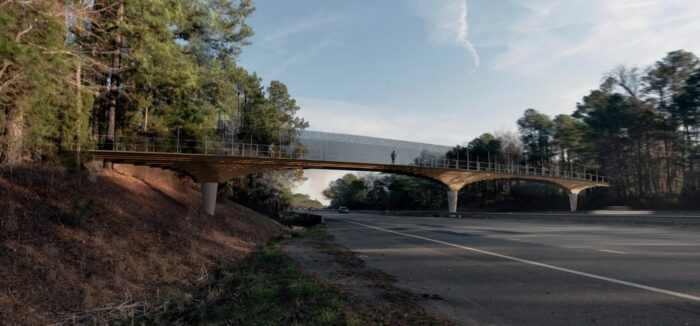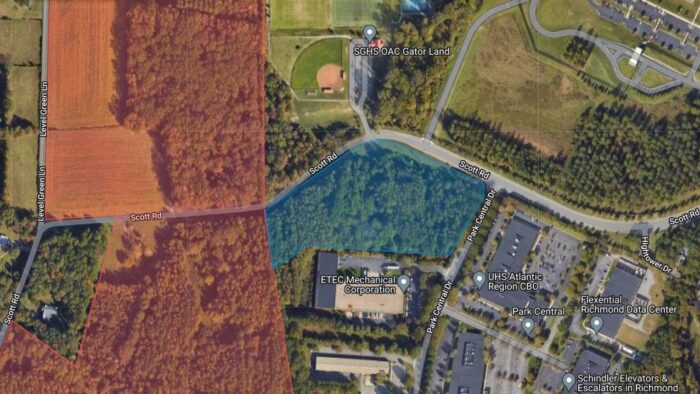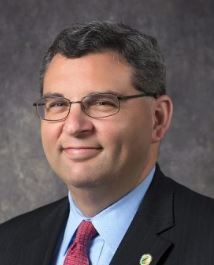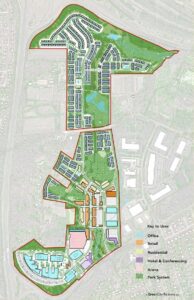A year after it purchased an adjacent athletic center, Henrico’s economic development arm is making further investments in land beside the massive GreenCity site.
Last week, the Henrico Economic Development Authority paid over $2 million for an 8.6-acre parcel along Scott Road immediately east of GreenCity, the arena-anchored development planned for 200 acres southeast of the I-95/295 interchange.
The wooded parcel is part of the Park Central office park and across Scott Road from the Saint Gertrude High School Outdoor Athletic Center, which the EDA bought last year for $4.5 million.
Where the 16-acre athletic center property is planned to supplement the GreenCity development as it’s built out, the wooded parcel is likewise expected to support the mixed-use project – though exactly how is to be determined, EDA Director Anthony Romanello said.
“We don’t have plans for it. It’s zoned industrial, so it could be a small commercial site, or it could be incorporated into GreenCity,” he said of the parcel, which had been listed for sale.
Romanello said the county had been working to secure about an acre’s worth of right-of-way along the northern edge of the property for its planned expansion of Magellan Parkway, which bisects GreenCity, when the decision was made to purchase the whole property.
“We just decided it was a good site and we would just pick up the whole thing for some future commercial use,” he said.
The parcel was listed by Porter Realty’s Kevin Cox for seller Steve Farag LLC, which had owned the property since 2009. County records show it purchased it for about $417,000. The property was assessed by the county this year at $695,200.
GreenCity prep continues

The planned pedestrian bridge that would replace the existing Scott Road bridge across I-95. (File images courtesy Future Cities)
Acquiring right-of-way for the Magellan Parkway widening has been one of Henrico’s areas of focus for GreenCity of late.
Other infrastructure improvements to support the massive development include a sewer extension project under I-295, to support the residential section being developed by Markel | Eagle; a new bridge across I-95 to connect Magellan with Brook Road; and a conversion of the now-closed Scott Road bridge into a bike and pedestrian bridge that would connect with the Fall Line Trail.
County Manager John Vithoulkas said progress continues on all of those fronts.
“I think we have two more small land acquisitions for the right-of-way, and everything on the bridge side is on time,” Vithoulkas said.
He said the timing for the rest of the project would be determined by the developers: Markel | Eagle, which is driving the bulk of the residential development; and Green City Partners and ASM Global, which are handling the commercial and arena components.
The $2.3 billion project is planned to include a 17,000-seat arena, two 300-room hotels, office and retail development, a rehab of the former Best Products headquarters building, green space, and a total of 2,400 residential units.
The arena is targeted for completion by the end of 2026, and Markel | Eagle has said for-sale homes could start being built in late 2025 or in 2026. Full build-out of the entire GreenCity project is anticipated in 2033.
The 111-acre Scott Farm property that makes up most of GreenCity’s residential section was secured last year through a $35 million purchase split by Henrico and Markel | Eagle, with the EDA pitching in about $1 million.
The 93-acre Best Products site that makes up the commercial portion was sold by the county last year to Green City Partners, the lead development entity led by Susan Eastridge of Fairfax-based Concord Eastridge and Michael Hallmark of Richmond-based Future Cities.
The $6.2 million Best Products site sale is being made in three installments, with the bulk of the payment – $5.22 million – due next year. The EDA has received the first two installments of $500,000 each, the second of which was due from Green City Partners this February.
The county expects to recoup its part of the $35 million Scott Farm purchase over 20 years from incremental tax revenues generated by GreenCity. Such revenues would be collected by a community development authority, which would issue bonds to finance a portion of the arena and infrastructure improvements within the commercial section.
A second CDA for GreenCity’s residential portion was established in December.
Similar to TIFs, or tax-increment financing districts, CDAs are a financing tool that governments can use to generate tax revenue to support a development as it progresses. Henrico has used CDAs with three other developments in the county: Short Pump Town Center, White Oak Village and Reynolds Crossing.
Vithoulkas said the private side of GreenCity’s development would determine the timing of the CDA bonds being issued.
“They’re doing their thing as far as continuing to do the work, and then (will) come back to us when they think they’ve reached a point where the model for the arena is funded by the revenues that come from the development,” Vithoulkas said.
“Everything on the public side has been done, so we’re just letting (the developers) see what they can do within the vested rights that they have to generate the revenues necessary for the CDA to work.”
A year after it purchased an adjacent athletic center, Henrico’s economic development arm is making further investments in land beside the massive GreenCity site.
Last week, the Henrico Economic Development Authority paid over $2 million for an 8.6-acre parcel along Scott Road immediately east of GreenCity, the arena-anchored development planned for 200 acres southeast of the I-95/295 interchange.
The wooded parcel is part of the Park Central office park and across Scott Road from the Saint Gertrude High School Outdoor Athletic Center, which the EDA bought last year for $4.5 million.
Where the 16-acre athletic center property is planned to supplement the GreenCity development as it’s built out, the wooded parcel is likewise expected to support the mixed-use project – though exactly how is to be determined, EDA Director Anthony Romanello said.
“We don’t have plans for it. It’s zoned industrial, so it could be a small commercial site, or it could be incorporated into GreenCity,” he said of the parcel, which had been listed for sale.
Romanello said the county had been working to secure about an acre’s worth of right-of-way along the northern edge of the property for its planned expansion of Magellan Parkway, which bisects GreenCity, when the decision was made to purchase the whole property.
“We just decided it was a good site and we would just pick up the whole thing for some future commercial use,” he said.
The parcel was listed by Porter Realty’s Kevin Cox for seller Steve Farag LLC, which had owned the property since 2009. County records show it purchased it for about $417,000. The property was assessed by the county this year at $695,200.
GreenCity prep continues

The planned pedestrian bridge that would replace the existing Scott Road bridge across I-95. (File images courtesy Future Cities)
Acquiring right-of-way for the Magellan Parkway widening has been one of Henrico’s areas of focus for GreenCity of late.
Other infrastructure improvements to support the massive development include a sewer extension project under I-295, to support the residential section being developed by Markel | Eagle; a new bridge across I-95 to connect Magellan with Brook Road; and a conversion of the now-closed Scott Road bridge into a bike and pedestrian bridge that would connect with the Fall Line Trail.
County Manager John Vithoulkas said progress continues on all of those fronts.
“I think we have two more small land acquisitions for the right-of-way, and everything on the bridge side is on time,” Vithoulkas said.
He said the timing for the rest of the project would be determined by the developers: Markel | Eagle, which is driving the bulk of the residential development; and Green City Partners and ASM Global, which are handling the commercial and arena components.
The $2.3 billion project is planned to include a 17,000-seat arena, two 300-room hotels, office and retail development, a rehab of the former Best Products headquarters building, green space, and a total of 2,400 residential units.
The arena is targeted for completion by the end of 2026, and Markel | Eagle has said for-sale homes could start being built in late 2025 or in 2026. Full build-out of the entire GreenCity project is anticipated in 2033.
The 111-acre Scott Farm property that makes up most of GreenCity’s residential section was secured last year through a $35 million purchase split by Henrico and Markel | Eagle, with the EDA pitching in about $1 million.
The 93-acre Best Products site that makes up the commercial portion was sold by the county last year to Green City Partners, the lead development entity led by Susan Eastridge of Fairfax-based Concord Eastridge and Michael Hallmark of Richmond-based Future Cities.
The $6.2 million Best Products site sale is being made in three installments, with the bulk of the payment – $5.22 million – due next year. The EDA has received the first two installments of $500,000 each, the second of which was due from Green City Partners this February.
The county expects to recoup its part of the $35 million Scott Farm purchase over 20 years from incremental tax revenues generated by GreenCity. Such revenues would be collected by a community development authority, which would issue bonds to finance a portion of the arena and infrastructure improvements within the commercial section.
A second CDA for GreenCity’s residential portion was established in December.
Similar to TIFs, or tax-increment financing districts, CDAs are a financing tool that governments can use to generate tax revenue to support a development as it progresses. Henrico has used CDAs with three other developments in the county: Short Pump Town Center, White Oak Village and Reynolds Crossing.
Vithoulkas said the private side of GreenCity’s development would determine the timing of the CDA bonds being issued.
“They’re doing their thing as far as continuing to do the work, and then (will) come back to us when they think they’ve reached a point where the model for the arena is funded by the revenues that come from the development,” Vithoulkas said.
“Everything on the public side has been done, so we’re just letting (the developers) see what they can do within the vested rights that they have to generate the revenues necessary for the CDA to work.”







In my opinion, in order for the arena to be completed by the end of 2026 (two and a half years) they need to break ground sooner rather than later. There are still supply chain issues, as well as labor issues to contend with.
Yes, and we’re still waiting on the new Diamond development to get started. The arena and the new stadium are supposed to open around the same time.
The same time; the arena is to open “the end of 2026” which I am assuming would be in the last quarter of the year. The stadium is to be OPEN on opening day of the 2026 minor league baseball season which is general before April 1st each year. Oct 1st and April 1st are six months apart so I think the City’s Diamond District is a little more up against a deadline than Henrico’s Green City at this point. Plus given the city’s history with CDAs and its horrible administration, they need an 6 months just to put together… Read more »
My prediction: The ballpark will be open before the arena commences construction. The arena will cost 2-3 x as much and it has no tenants. How many monster truck shows can it book each year? I just don’t see it happening in today’s debt environment.
100% agreed, Bruce.
Oh… in addition to the monster truck shows and tractor pulls, there’s always the Ice Capades.
Hmmm… I wonder if Linda Fratianne is still skating?